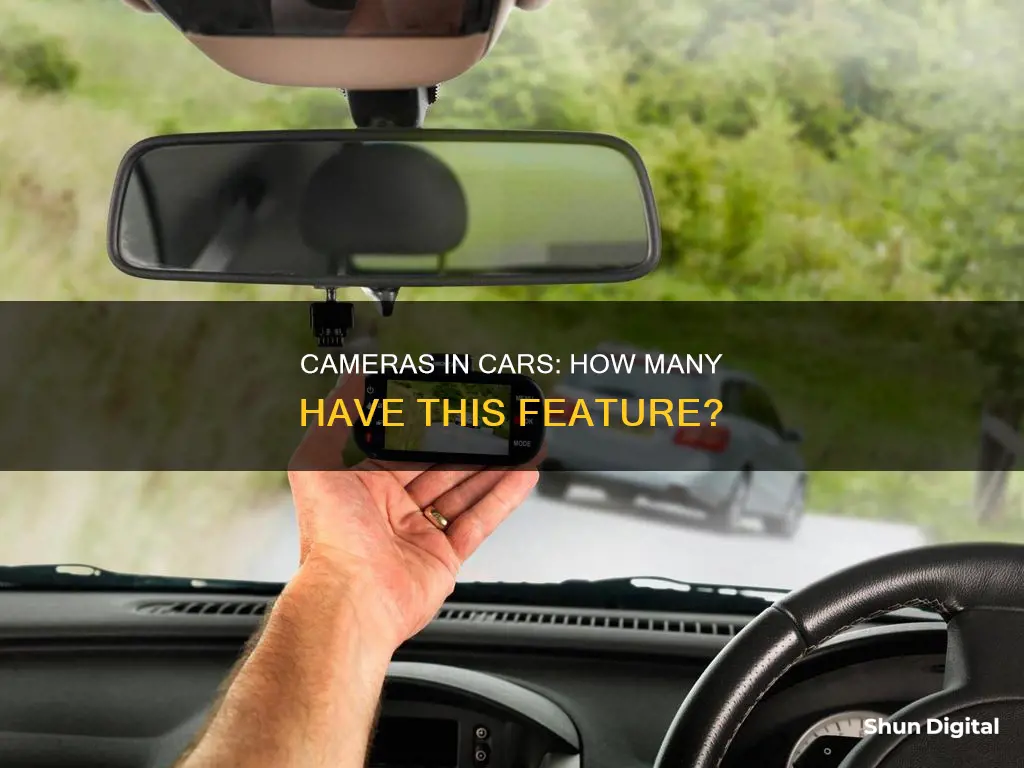
Cars with built-in cameras are becoming increasingly common, with many manufacturers offering vehicles with dashcam functionality. These cameras can be used for a variety of purposes, including establishing liability in the event of a crash, recording footage for insurance purposes, or even just recording a fun road trip. In addition to dashcams, some cars also have interior cameras that can be used to monitor the driver's awareness and attention to the road. As the demand for high-tech features in vehicles continues to grow, it's likely that we'll see even more cars with built-in cameras in the future.
| Characteristics | Values |
|---|---|
| Number of cameras in a car | Up to 16 cameras and sensors in the 2019 Kia K900 |
| Camera placement | Inside or outside the car, or both |
| Camera functionality | Blindspot assistance, parking assistance, driver monitoring, dashcam functionality, etc. |
| Camera control | Some cameras can be turned off or disabled by the driver |
| Data storage | Footage may be stored on the car's internal storage, a USB stick, or an SD card |
What You'll Learn
- Dashcams are becoming a must-have accessory for drivers
- In-car cameras can improve vehicle security, safety and convenience
- Cameras can help cars see their surroundings and propel them towards an autonomous future
- Cameras can be used to combat drunk driving by analysing the driver's face and behaviour
- Some car companies are installing in-cabin cameras to monitor the driver and allow the car to intervene

Dashcams are becoming a must-have accessory for drivers
Dashcams are becoming an essential accessory for drivers, offering a range of benefits that enhance safety, security, and convenience. Here are several reasons why dashcams are a must-have for today's drivers:
Evidence in the Event of a Crash
Dashcams can provide invaluable evidence in the event of a road accident. They can establish the sequence of events, record what happened, and help determine liability and fault for insurance purposes. This can expedite insurance claims and ensure a fair resolution for all parties involved.
Theft Prevention and Security
Dashcams with remote accessibility can also aid in theft prevention. If your car is stolen, you can access the footage to identify the thief and provide proof to the authorities. Additionally, some dashcams offer a ""sentry mode" or "parking mode," which detects and records suspicious behaviour around the vehicle when it is parked, potentially deterring thieves and vandals.
Recording Special Drives and Road Trips
Dashcams can also serve as a fun way to record special drives or road trips. Many models offer time-lapse recording modes, allowing you to capture memorable journeys and scenic routes. You can relive these experiences and share them with friends and family.
Improved Driving Habits
Dashcams can encourage safer driving habits. Reviewing footage of your own driving can help you identify areas for improvement and make you a more cautious and attentive driver. This can also lead to insurance benefits, as safer driving records often result in premium discounts.
Convenience and Peace of Mind
With a dashcam, you don't have to worry about manually capturing important moments on the road. The continuous recording feature ensures that you won't miss any critical incidents. Additionally, some dashcams offer features like emergency calling, voice control, and alerts for speed cameras and red-light cameras, further enhancing your peace of mind while on the road.
Integration with Modern Vehicles
Dashcams are becoming increasingly integrated with modern vehicles. Some carmakers offer vehicles with built-in dashcam functionality, seamlessly incorporating the camera with the car's advanced driver assistance systems and active safety features. This eliminates the need for aftermarket installations, ensuring a sleek and tidy setup.
In conclusion, dashcams offer a wide range of benefits that enhance safety, security, and convenience for drivers. They provide valuable evidence in accidents, aid in theft prevention, capture special drives, encourage safer driving, and offer modern conveniences. As a result, dashcams are becoming an essential accessory for drivers seeking peace of mind and an extra layer of protection on the road.
Bypassing Your Computer Camera: Tips and Tricks
You may want to see also

In-car cameras can improve vehicle security, safety and convenience
In-car cameras can be a highly effective way to improve vehicle security, safety, and convenience. They can act as a deterrent to theft and vandalism, provide evidence in the event of an insurance claim, and offer peace of mind to drivers.
Security
The presence of in-car cameras can act as a powerful deterrent to potential thieves and vandals. With round-the-clock surveillance, car owners can monitor their vehicles even when they are not physically present. This is especially useful for overnight parking, where the risk of vehicle theft and vandalism is higher. Security cameras with motion detection and night vision capabilities can capture clear footage of any suspicious activity, providing valuable evidence for insurance claims and criminal investigations.
Safety
In-car cameras, such as dashcams, can improve road safety by recording the events leading up to a crash, helping to establish liability and determine fault. This can be crucial for insurance purposes. Additionally, dashcams can also record special drives or road trips, providing a unique way to relive memorable moments. Some dashcams offer time-lapse recording modes specifically designed for this purpose.
Convenience
In-car camera technology has advanced to the point where it can now be seamlessly integrated into the vehicle's design. Built-in dashcams, for example, eliminate the need for dangling wires associated with aftermarket installations. This enhances the overall aesthetics and convenience of the car's interior. Additionally, certain car models offer advanced features such as remote viewing of a live stream of the car's surroundings, providing real-time updates to the owner.
In conclusion, in-car cameras offer a multitude of benefits to drivers, including enhanced security, improved safety, and added convenience. With the increasing availability of built-in camera options and advanced features, in-car cameras are becoming an essential accessory for modern drivers.
Dragon Camera Tickets: Are You Obliged to Pay Fines?
You may want to see also

Cameras can help cars see their surroundings and propel them towards an autonomous future
Cameras are becoming an integral part of modern cars, and for good reason. They are a driver's eyes on the road, providing an array of benefits that enhance safety and convenience. With their advanced technology, cameras can now assist drivers in a multitude of ways, from basic recording functions to complex safety features.
One of the most prominent uses of cameras in cars is for dashcam functionality. Dashcams are becoming increasingly popular and offer a wide range of advantages. In the event of a crash, they can be invaluable for establishing liability and determining fault for insurance purposes. They can also capture special drives or road trips, providing a unique way to record memories. Additionally, dashcams can aid in theft detection by remotely providing proof that a car has been stolen.
Beyond dashcams, cameras are also being utilized for advanced driver assistance systems (ADAS). These safety cameras have a multitude of functions, including lane departure warnings, collision warnings, active cruise control, emergency braking, headlight control, and traffic sign recognition. One of the key advantages of these cameras is their ability to identify objects surrounding the car better than radar. This enhances the overall safety of the vehicle by providing the driver with a more comprehensive understanding of their surroundings.
The placement of these cameras is also strategic. When mounted behind the windshield, they offer an ideal viewing perspective and are easier to service due to their accessibility. Furthermore, engineers have addressed challenges with moisture collection in camera housings by connecting them to the car's HVAC system, ensuring their operational longevity.
The data collected by these cameras is incredibly valuable not only for automotive safety but also for various other applications. Companies like Mobileye and Carmera are utilizing data from vehicle sensors to create detailed maps and profiles of cities, which can be used to improve infrastructure and urban planning. For example, they can identify areas with frequent crashes, excessive speeding, or a high concentration of cyclists and pedestrians, enabling cities to make data-driven decisions to enhance safety.
While there are concerns about data privacy and the potential misuse of information collected by these cameras, the benefits they provide in terms of safety and autonomous driving capabilities are undeniable. As technology continues to advance, we can expect to see even more sophisticated camera systems in cars, propelling us towards a future of autonomous driving and enhanced road safety.
Protect Your Privacy: Disable Your Computer Camera
You may want to see also

Cameras can be used to combat drunk driving by analysing the driver's face and behaviour
In-car cameras are an increasingly common feature, with the potential to improve road safety by combating drunk driving and driver distraction. Volvo, for instance, has announced plans to introduce in-car cameras across all its vehicles to monitor driver behaviour, including eye movements, to detect intoxication and distraction. This technology could prevent a drunk driver from operating the vehicle by slowing the car down and even stopping it. It could also call emergency services and pull over if the driver is inattentive.
The use of cameras to prevent drunk driving is not a new concept. Scientists at Edith Cowan University in Australia have developed image recognition software that uses artificial intelligence to determine whether a person is drunk and how much they have consumed. This technology takes into account the direction of gaze and head position, among other factors. In the EU, all new cars must have an interface for a breathalyser, and in-car cameras with image recognition software could simplify the process of detecting drunk drivers.
While some may raise concerns about privacy invasion, Volvo has emphasised that its camera system will only collect data to make its cars safer and with the user's consent. Additionally, the exact technical setup of the camera has yet to be decided. In-car cameras have the potential to save lives and reduce the number of accidents caused by drunk driving. According to NHTSA, almost 30% of all fatal accidents in the US in 2017 involved an intoxicated driver.
Dashcams are another type of camera that is becoming increasingly popular in vehicles. While primarily used to record the road ahead for insurance purposes or to capture fun road trips, dashcams can also be used to monitor driver behaviour. For example, the BMW Drive Recorder can record from multiple cameras simultaneously and save footage before and after a collision. With the development of advanced image recognition software and the increasing prevalence of in-car cameras, it is likely that we will see more effective ways to combat drunk driving and improve road safety in the future.
The Evolution of the First Multiplane Camera
You may want to see also

Some car companies are installing in-cabin cameras to monitor the driver and allow the car to intervene
In-cabin cameras are being installed in cars by some car companies to monitor the driver and allow the car to intervene. This technology is designed to improve safety and comfort for drivers and passengers. In-car cameras first started appearing in luxury vehicles almost two decades ago and have since become more common. They were initially developed to help drivers keep their eyes on the road and have since evolved to support hands-free automated driving.
Volvo announced in 2019 that it would install in-cabin cameras in all of its vehicles to monitor the driver and allow the car to intervene if the driver is intoxicated or distracted. Similarly, Tesla has switched on a driver-facing camera in some of its Model 3 and Model Y vehicles to ensure drivers are paying attention to the road when using Autopilot, its driver assistance system.
In-cabin cameras can be calibrated to detect risky behaviours like not wearing a seatbelt, eating or drinking, or looking at handheld devices, and will provide audio/visual alerts in real time. They can also be used to adjust vehicle settings, such as seat and side-mirror positions, for different drivers.
However, the use of in-cabin cameras has raised privacy concerns. Some drivers are reluctant to have cameras monitoring them while they work and recording them in private areas, such as sleeping berths. There is also the potential for abuse, as seen in the case of Tesla employees who shared invasive videos and images recorded by in-car cameras.
To address these concerns, some companies have implemented measures to protect driver privacy. For example, Tesla notes that its camera recordings remain anonymous and are not linked to the vehicle or its owner. Additionally, data sharing can be enabled or disabled by the driver through the vehicle's touchscreen controls.
Charging the Playskool Camera: A Quick Guide
You may want to see also
Frequently asked questions
It is challenging to provide an exact number, but it is safe to say that many modern cars are equipped with built-in cameras. This trend is expected to grow, with the global automotive camera market projected to almost double in the next 6 years, reaching a value of $15 billion.
Built-in car cameras, often referred to as dashcams, offer several advantages. They can be useful in the event of a crash, helping to establish liability and determine fault for insurance purposes. Dashcams can also aid in the recovery of a stolen vehicle and provide a unique way to record memorable road trips. Additionally, some car cameras assist with parking, provide a bird's-eye view of the vehicle's exterior, and even enable semi-autonomous driving features.
Several car manufacturers have recognized the demand for built-in cameras and have incorporated them into their designs. This includes Tesla, BMW, Mercedes-Benz, BYD, Hyundai, and Kia. Each manufacturer may have different camera placements and features, but they all contribute to enhancing vehicle security, safety, and convenience.







